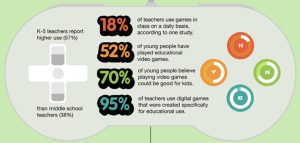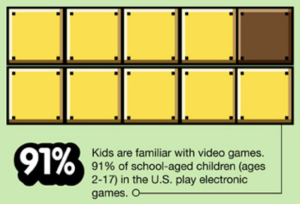In recent years, game-based learning (or ‘Gamification’ as it is sometimes called), has become an established part of formal education in both K-12 and higher education.
It’s not hard to see why. Research has demonstrated that those who take part in game-based learning benefit from enhanced memory retention as well as enhanced performance when repeating a gamified task in real life.
And yet, in workplace, it’s my observation that game experiences still have serious untapped potential to enhance L&D.
This is despite a recent survey indicating that 83% of employees reported feeling motivated while taking gamified training, compared to 61% feeling bored or unproductive during non-gamified training.


Source: https://edtechmagazine.com/k12/article/2012/10/do-students-benefit-game-based-learning-infographic
We mustn’t ignore these benefits
This boost in engagement and motivation should be seen as gold dust.
It can lead to greater knowledge retention, ultimately making the training more effective.
It can also increase the learning that employees want to do, which can yield higher participation and completion rates not only for mandatory training but for valuable up-skilling and other learning opportunities as well.
Scoring big with learners across generations
It’s also worth remembering that the benefits of adopting a game-based training strategy may have never been greater than they are now, as Gen Z is imminently set to become the larger portion of the workforce – a generation that consistently calls for new ways of working and learning.
According to a Workplace Culture Report, Gen Z are the most bored generation at work at 95%, with online training regarded by them as the #1 opportunity they have to tune out.
However, 59% of Gen Z employees also said friendly competition would help them feel more engaged in training and other work contexts.
This affinity for game-based learning is unsurprising considering many Gen Z’ers grew up with educational games in the classroom.
However, research actually shows the instinct for friendly competition transcends age.
A recent study by Sales Screen, for example, found older employees viewed game elements, such as leader boards and prizes, as being just as motivating as Gen Z employees did.
As such, this can make game-based learning a great way to facilitate team bonding and build a sense of camaraderie among employees of different ages and backgrounds.
So how can learning professional power up their L&D strategy? I would say they should concentrate on a few key areas:
Tap into learners’ social instincts
One of the most important (and often overlooked), factors in an employee’s engagement level is their interaction with coworkers.
It can be difficult to keep employees motivated to learn on their own, even with gamified elements.
By making it a shared, interactive game experience, we can harness people’s instinct for friendly competition, whether they’re competing solo or as a team.
In addition to self-paced, on-demand learning, create opportunities for real-time group participation in a game experience – in-person or virtually.
Start with events where the team will already be together, such as all-hands meetings, team training days, and company gatherings.
Elevate the experience with technology
While low-tech or no-tech elements, such as wall leaderboards, trophies, or other prizes, can gamify training and increase employee motivation to a degree, technology can create more immersive experiences that improve learning outcomes.
Instead of simply providing an incentive to complete a dry, boring training, make the training itself enjoyable by delivering it through digital game-based learning platforms.
Technology can also make learning more accessible and inclusive for all employees, no matter where they’re located, and whether they work in-person, hybrid, or remote.
Cultivate collaboration with peer learning
If you want to make training and L&D sessions more social and participatory, one of the most powerful ways to start is with a peer leader.
When a learning session is hosted by a fellow team member, it can feel more authentic.
They can relate-to, and address specific challenges for their team, and in the case of game-based learning, it can help employees to let loose and participate more freely.
And research indicates employees have plenty of knowledge to contribute, with 58% of workers reporting they hold un-shared knowledge that could benefit their coworkers, and 77% of employees saying they would greatly value an easy, fun way to share knowledge with their team.
To equip more employees to be learning leaders, choose user-friendly digital platforms that make it easy for anyone to create engaging, game-based learning experiences for their coworkers.
Iterate and innovate for your unique workforce
Flexibility is key when integrating friendly competition into your learning strategy in the workplace.
No two workforces are the same, nor do their needs remain static over time. This demands a fluid approach, as well as technology that can adapt to different preferences and contexts.
First, explore the features your digital learning platforms offer, and get inspiration from seeing how other companies are using these tools.
Consider your team’s unique needs, personalities, and goals, to experiment with facilitating game-based training or L&D sessions in different ways. Then, analyze the data – both qualitative and quantitative – to learn and refine your approach.
Discover what gets participants most excited or engaged, and identify knowledge gaps that need filling. As you progress, keep iterating on the content and experience to keep it fresh and resonant for your particular audience.
Conclusions
Introducing friendly competition into L&D can transform the learning experience, engaging and energizing employees young and old to grow their knowledge and build key skills.
When implemented with a thoughtful strategy and ongoing adaptation, game-based training can play a key role in achieving a happier, more collaborative, and more agile workforce.
